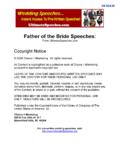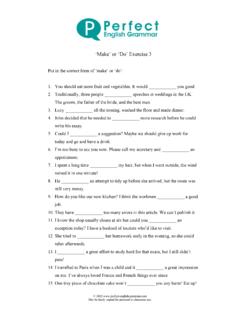Transcription of Wedding Traditions and Who Does What – Park …
1 Wedding Traditions and Who does what Park Hotel, Montrose, Angus The Dress White was the colour which the ancient Romans believed would ward off evil spirits. It had nothing to do with purity or virginity, the veil was also designed to protect the bride from evil spirits seeing her beauty and being jealous. The Wedding Bouquet In olden days this was made up of strong smelling herbs to frighten away evil spirits, and to surround the couple with beauty. Most flowers have their own meaning. The bouquet used to always contain orange blossom which symbolised fertility. The Cake The cake is a very ancient feature of the marriage feast. The richer the mixture the more abundant the marriage would be. The original mix was of sesame seed and honey.
2 The first slice should always be cut by the bride and bridegroom. Photography The first photograph was taken in France in 1826. It took eight hours to make the exposure. Luckily today s bride and bridegroom don t have to stand still that long. In 1853 William Fox Talbot of Britain invented the process of making a negative from which later prints could be taken. The first colour photograph was taken in 1861. Tossing the Slice Believing that newlyweds brought good luck, they were showered with nuts and grains to ensure a bountiful harvest. This has now become the throwing of confetti. Transport Today s practice of using vintage cars and horse-drawn vehicles probably began about 30 years ago and sets the scene in the manner of the elegant 20 s Throwing of Old Shoes This was the traditional way of transferring the responsibility of the bride s father to her new husband now best kept alive by tying shoes to the back of cars.
3 The Honeymoon Centuries ago. it was customary for the Bride and Bridegroom to drink mead (a wine made from honey) for a month after the Wedding . A month was known as moon hence honeymoon. The Perfect Reception At the reception the usual line-up waiting to greet the guests is as follows, Bride and groom , Bride s Parents, groom s Parents, Bridesmaids and Best Man. The line-up ensures that both families have the opportunity to speak to all the guests, but conversation should be kept to a polite minimum as the queue can become unwieldy. Toasts and Speeches These would normally take place at the end of the meal although more couples are deciding on speeches before the meal, the decision is yours. The following is the usual order of proceedings: 1.
4 Toast to the Bride and Bridegroom . This is normally proposed by the Bride s father . 2. Toast to the Bridesmaids . This is always proposed by the groom 3. The Best Man would then respond to the Bridegroom s speech on behalf of the Bridesmaids. He would also read any special greeting cards to the guests. The Etiquette The tradition and conventions of Wedding etiquette will not suit everyone but it is important to be aware of them. This explanation of who does what in the preparations and ceremony aims to enable you to make an informed decision on the best way to run your Wedding day. THE BRIDE The Bride traditionally selects the type of service. She oversees all the preparations, which include choosing the date and the church, who her attendants will be, her own dress and accessories, as well as those of the bridesmaids.
5 She will choose the flowers, help with the guest list and seating arrangements, and attend to the many small details which will contribute to her perfect day. THE groom The groom has to arrange transport for himself, the bride and the Wedding party, as well as hiring the church and booking the honeymoon. However, this will be done with direction from his future wife. The groom chooses his best man and ushers, of which it is traditional to have three, and is conventionally given responsibility for little else! However, in reality, the bride and groom discuss most aspects of the day as it is, after all, their Wedding . At the reception, the groom will reply to the father of the bride s speech, thanking the bride s parents and guests, and proposing a toast to the bridesmaids.
6 THE BEST MAN Traditionally, the best man is responsible for his own dress and that of the groom . He sees that transport to the church for them both is arranged, and also organises the stag night , preferably several days or even weeks in advance, if he is to successfully fulfil his duty of escorting the groom to the church on time. On the day, the best man has to ensure that the whole day runs smoothly, primarily ensuring safe keeping of the rings. After the ceremony, he is responsible for transportation of all the guests to the reception, replying to the groom s toast to the bridesmaids, and will read out a few cards from the guests unable to attend. His final responsibility of the day is to ensure that the bride and groom leave the reception in good time, and that their transport is arranged.
7 THE CHIEF BRIDESMAID The Chief bridesmaid is chosen by the bride to assist her during the preparations. On the day itself, it is her job to make sure that all the other attendants are in their places. She will arrange the bride s dress and veil when she arrives, ready for her entry into the church. During the service, she holds the bride s bouquet. The Chief Bridesmaid also signs the register, along with the best man. She is then escorted by the best man, and will be on hand all day to assist the bride. THE USHERS The ushers greet the guests as they arrive at the church. They will distribute the service sheets and show people to their seats. If it is raining they will help escort the guests and bridal party from their cars to the church under umbrellas.
8 THE father OF THE BRIDE Much of the father of the bride s responsibility lies with the financial aspect of the event, traditionally, he pays for the bulk of the costs. Nowadays, though, it is likely that the bride and groom will meet some of the expenses themselves and also a possibility that the groom s family will make some contribution. On the day, the bride will be accompanied to the church by her father , who will escort her up the aisle and give her away during the ceremony. The bride s father will sit next to the bride on the top table during the Wedding breakfast, and will make the first speech, in which he proposes a toast to the bride and groom . THE BRIDE S MOTHER The Bride s mother will help her daughter with the Wedding arrangements and may have a major role in the decisions taken, especially if she is contributing financially.
9 She will compile the guest list, in consultation with the groom and his parents. She may organise the sending out of invitations, and the display of the Wedding gifts. The bride s mother will not only stand proudly watching her daughter on this special day, but is there to oversee all the arrangements, as well as stand in line to greet the guests, along with her husband. THE groom S PARENTS There is no specific traditional role for the groom s parents, but it is important that they do not feel neglected. Today, it is not unusual for the groom s parents to make a considerable contribution to organisation and payment. It is only good manners on the part of the bride, to ask their advice and approval and ensure they are included as much as possible in the preparations.
10 We have listed below items from our checklist of things that need to be done during the organisation of your Wedding . Agree your Budget Decide date and venue Arrange Church/venue Book reception Book evening Party Book entertainment Book photographer/videographer Book toastmaster Order transport Decide on number of guests Order invitations Choose Wedding Dress Choose Bridesmaids Choose Best Man and Ushers Order Wedding Cake Book Honeymoon Make Wedding present list Confirm legal arrangements Buy Bridesmaid s Dresses Order flowers, balloons etc Choose Wedding rings Send out invitations Arrange hen/stag night Check passports are valid Choose hymns for service Choose bridesmaids presents Confirm travel arrangements Arrange men s suit hire Confirm numbers with caterers Make beauty appointments Confirm car hire.

